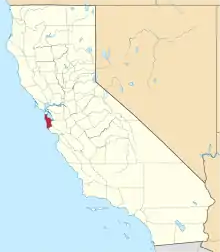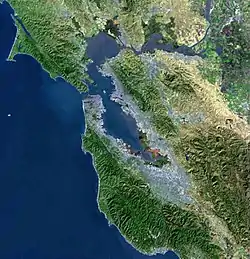Moss Beach, California
Moss Beach is a coastal census-designated place in San Mateo County, California, with a year 2010 census population of 3,103. Located in Moss Beach are the Fitzgerald Marine Reserve, a marine sanctuary; the Half Moon Bay Airport, the historic Moss Beach Distillery; and the Seal Cove Inn, a destination lodging property. Moss Beach is a cool coastal microclimate that gives one a sense of separation from the nearby metropolitan San Francisco Bay Area and assures that summer temperatures are generally mild.
Moss Beach | |
|---|---|
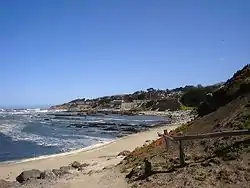 Moss Beach shoreline, April 2007. Part of the Franciscan formation is visible near the beach | |
 Location in San Mateo County and the state of California | |
 Moss Beach Location in the United States | |
| Coordinates: 37°31′31″N 122°30′46″W | |
| Country | |
| State | |
| County | San Mateo |
| Area | |
| • Total | 2.254 sq mi (5.837 km2) |
| • Land | 2.254 sq mi (5.837 km2) |
| • Water | 0 sq mi (0 km2) 0% |
| Elevation | 66 ft (20 m) |
| Population | |
| • Total | 3,103 |
| • Density | 1,400/sq mi (530/km2) |
| Time zone | UTC-8 (Pacific) |
| • Summer (DST) | UTC-7 (PDT) |
| ZIP code | 94038 |
| Area code | 650 |
| FIPS code | 06-49446 |
| GNIS feature ID | 1659183 |
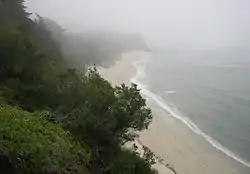
Geography
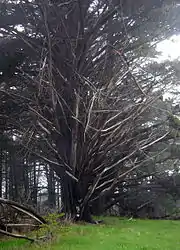
Moss Beach is situated at 37°31'31" North latitude, 122°30'46" West (37.525240, -122.512811),[3] approximately 20 miles (32 km) south of San Francisco and 50 miles (80 km) north of Santa Cruz, California. Nearby towns include Montara to the north, El Granada, Princeton-by-the-Sea, and Half Moon Bay to the south. According to the United States Census Bureau, the CDP has a total area of 2.3 square miles (6.0 km2), all land.
Demographics
2010
The 2010 United States Census[4] reported that Moss Beach had a population of 3,103. The population density was 1,377.0 people per square mile (531.6/km2). The racial makeup of Moss Beach was 2,280 (73.5%) White, 25 (0.8%) African American, 43 (1.4%) Native American, 118 (3.8%) Asian, 9 (0.3%) Pacific Islander, 494 (15.9%) from other races, and 134 (4.3%) from two or more races. Hispanic or Latino of any race were 903 persons (29.1%).
The Census reported that 2,983 people (96.1% of the population) lived in households, 12 (0.4%) lived in non-institutionalized group quarters, and 108 (3.5%) were institutionalized.
There were 1,062 households, out of which 359 (33.8%) had children under the age of 18 living in them, 607 (57.2%) were opposite-sex married couples living together, 85 (8.0%) had a female householder with no husband present, 41 (3.9%) had a male householder with no wife present. There were 49 (4.6%) unmarried opposite-sex partnerships, and 14 (1.3%) same-sex married couples or partnerships. 251 households (23.6%) were made up of individuals, and 68 (6.4%) had someone living alone who was 65 years of age or older. The average household size was 2.81. There were 733 families (69.0% of all households); the average family size was 3.35.
The population was spread out, with 710 people (22.9%) under the age of 18, 234 people (7.5%) aged 18 to 24, 699 people (22.5%) aged 25 to 44, 1,097 people (35.4%) aged 45 to 64, and 363 people (11.7%) who were 65 years of age or older. The median age was 43.2 years. For every 100 females, there were 99.9 males. For every 100 females age 18 and over, there were 97.6 males.
There were 1,154 housing units at an average density of 512.1 per square mile (197.7/km2), of which 868 (81.7%) were owner-occupied, and 194 (18.3%) were occupied by renters. The homeowner vacancy rate was 1.2%; the rental vacancy rate was 6.3%. 2,448 people (78.9% of the population) lived in owner-occupied housing units and 535 people (17.2%) lived in rental housing units.
2000
As of the 2000 census[5] there were 1953 people, 740 households, and 526 families residing in the Census Designated Place (CDP). The population density was 1,092.5 people per square mile (421.3/km2). There were 771 housing units at an average density of 431.3 per square mile (166.3/km2). The racial makeup in 2010 was 62.9% non-Hispanic White, 0.7% non-Hispanic African American, 0.2% Native American, 3.8% Asian, 0.3% Pacific Islander, 0.3% from other races, and 2.6% from two or more races. 29.1% of the population were Hispanic.
There were 740 households, of which 36.1% had children under the age of 18, 58.9% were married couples, 7.4% had a female householder with no husband present, and 28.9% were non-families. 18.4% of all households were made up of individuals, and 2.6% had someone living alone who was 65 years of age or older. The average household size was 2.64 and average family size was 2.98.
The median household income was $91,992, and the median family income was $99,307. Males had a median income of $81,619 versus $41,411 for females. The per capita income was $41,283. 4.3% of the population and 3.2% of families were below the poverty line. 2.2% of those under the age of 18 and 2.7% of those over 64 were below the poverty line.
Climate
Moss Beach has a Mediterranean climate (Köppen Csb) typical of the West Coast that is characterized by mild, rainy winters and cool, mild to warm summers, with an average temperature of 55°F (13 °C).
The area experiences some warmer degrees than Half Moon Bay due its nearest to San Francisco and coastal influence fog all year round and an Indian summer.
There is no significant snow occurring in Moss Beach in winter months, unless very rare snowfall in higher latitudes. Though snowfall along the coast in Moss Beach has never been measurable, however, snow flurries were observed on December 1972 and 1976.
Hot weather is not unusual; the average annual days with highs of 90 °F (32 °C) or higher can occur in summertime. Cold weather is also rare with lows of 44.3 °F (6.8 °C) or lower.[6] Typical of Northern California, most of the rain falls from November to April. The normal annual precipitation is 27.2 inches (691 mm).[6] There is often fog and overcast during the night and morning hours, usually clearing to offshore during the afternoon. Persistent sea breezes help to moderate the climate along the coast.
January is the coolest month with an average high of 57.5 °F (14.2 °C) and an average low of 44.3 °F (6.8 °C). August and September are the warmest months with an average high of 70.6 °F (21.4 °C) and an average low of 53.8 °F (12.1 °C) within the summer months.
| Climate data for Moss Beach, California | |||||||||||||
|---|---|---|---|---|---|---|---|---|---|---|---|---|---|
| Month | Jan | Feb | Mar | Apr | May | Jun | Jul | Aug | Sep | Oct | Nov | Dec | Year |
| Average high °F (°C) | 57.5 (14.2) |
59.6 (15.3) |
61.1 (16.2) |
62.9 (17.2) |
64.8 (18.2) |
67.9 (19.9) |
69.2 (20.7) |
70.1 (21.2) |
70.6 (21.4) |
68.3 (20.2) |
62.5 (16.9) |
57.6 (14.2) |
64.3 (18.0) |
| Daily mean °F (°C) | 50.9 (10.5) |
52.6 (11.4) |
53.7 (12.1) |
55.0 (12.8) |
57.4 (14.1) |
60.0 (15.6) |
60.6 (15.9) |
62.4 (16.9) |
62.2 (16.8) |
59.9 (15.5) |
55.2 (12.9) |
51.2 (10.7) |
56.8 (13.8) |
| Average low °F (°C) | 44.3 (6.8) |
45.6 (7.6) |
46.3 (7.9) |
47.1 (8.4) |
49.9 (9.9) |
52.0 (11.1) |
53.9 (12.2) |
54.6 (12.6) |
53.8 (12.1) |
51.5 (10.8) |
47.8 (8.8) |
44.8 (7.1) |
49.3 (9.6) |
| Average precipitation inches (mm) | 5.3 (130) |
5.1 (130) |
3.8 (97) |
1.7 (43) |
0.8 (20) |
0.2 (5.1) |
0.1 (2.5) |
0.2 (5.1) |
0.3 (7.6) |
1.4 (36) |
3.1 (79) |
5.2 (130) |
27.2 (685.3) |
| Average rainy days | 12 | 12 | 11 | 7 | 5 | 3 | 2.5 | 3 | 4 | 5 | 9 | 11 | 84.5 |
| Source: [7] | |||||||||||||
Politics
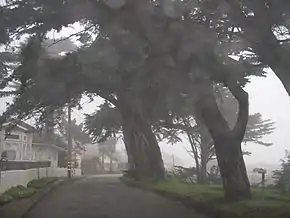
In the California State Legislature, Moss Beach is in the 13th Senate District, represented by Democrat Josh Becker, and in the 22nd Assembly District, represented by Democrat Kevin Mullin.[8]
Federally, Moss Beach is in California's 14th congressional district, represented by Democrat Jackie Speier.[9]
Noteworthy features
Due to the marine air currents off the Pacific Ocean, Moss Beach experiences above average fog levels, but also superior ambient air quality. Note the everpresent fog in the photo to the right (the circular blotches are not a special effect, but a result of the droplets formed on the camera lens cover). Situated along the coast of Moss Beach is the Fitzgerald Marine Reserve, a California designated area of Special Biological Significance. The reserve boasts a scenic blufftop trail through ancient cypress groves overlooking the Pacific Ocean, historically interesting tidepools and a variety of significant marine animals and pelagic birds. The unique outcroppings along the beach are part of the Franciscan formation, a favorite of local geologists.[10]
Montara State Marine Reserve & Pillar Point State Marine Conservation Area extend offshore from Moss Beach. Like underwater parks, these marine protected areas help conserve ocean wildlife and marine ecosystems.
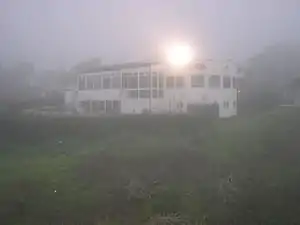
An occurrence of the rare plant Hickman's potentilla, Potentilla hickmanii, was observed by E.C. Suttliffe in 1933[11] in the vicinity of the mouth of San Vicente Creek within Moss Beach. This colony was not further documented for decades, but another colony was discovered[12] toward the end of the 20th century north of Moss Beach. The plant was listed as an endangered species by the United States government in 1998, and had previously been listed as California endangered in 1973.
Off State Route 1, one finds Moss Beach Distillery. This present day restaurant has its roots in bootleg liquor during Prohibition. This building is a California Point of Historical Interest. The restaurant claims to be haunted and was featured on the television series Ghost Hunters, wherein they found their paranormal claims to be fraudulent by revealing that owners of the distillery have created various hoaxes simulating paranormal activity.
References
- "2010 Census U.S. Gazetteer Files – Places – California". United States Census Bureau.
- "Moss Beach". Geographic Names Information System. United States Geological Survey. Retrieved April 18, 2015.
- "US Gazetteer files: 2010, 2000, and 1990". United States Census Bureau. 2011-02-12. Retrieved 2011-04-23.
- "2010 Census Interactive Population Search: CA - Moss Beach CDP". U.S. Census Bureau. Archived from the original on July 15, 2014. Retrieved July 12, 2014.
- "U.S. Census website". United States Census Bureau. Retrieved 2008-01-31.
- "Moss Beach, California". Retrieved 19 July 2020.
- "Statewide Database". UC Regents. Archived from the original on February 1, 2015. Retrieved November 29, 2014.
- "California's 14th Congressional District - Representatives & District Map". Civic Impulse, LLC. Retrieved March 12, 2013.
- College of San Mateo Geology Department
- U.S. Federal Register: August 2, 1995 Volume 60, Number 148, Pages 39326-39337
- Fremontia 21(1):25-29 (1993) and 24(1):3-11 (1996)
External links
| Wikivoyage has a travel guide for Moss Beach. |
